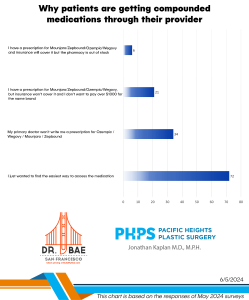 The distinctions between a cosmetic patient and an insurance patient may seem obvious. Yes, the cosmetic patient is receiving non-medically necessary services so they pay for everything out of pocket. Yes, the insurance patient is receiving medically necessary care and insurance will cover it – maybe. Aside from patients that are paying out of pocket due to a high deductible health plan, these difference are generally accurate.
The distinctions between a cosmetic patient and an insurance patient may seem obvious. Yes, the cosmetic patient is receiving non-medically necessary services so they pay for everything out of pocket. Yes, the insurance patient is receiving medically necessary care and insurance will cover it – maybe. Aside from patients that are paying out of pocket due to a high deductible health plan, these difference are generally accurate.
In the case of an insurance patient, they often just go with the doctor within their insurance network (not much choice). In contrast, the cosmetic patient can choose anyone they want. Simply by having a choice engenders a difference in expectations. Even still, I didn’t fully appreciate some of these differences in expectations until talking to one of my patients.
Things to keep in mind with the cosmetic patient vs the insurance patient
Of course every doctor should treat every patient, whether they’re using insurance or not, with respect. The primary goal is for the doctor to treat them to the best of their ability and safely. But after that minimum requirement, differences do emerge.
Think about when you go see a doctor for a medically necessary service. Your insurance requires you to pay a copay. Then potentially, your insurance covers a portion or all of the actual treatment. Regardless of whether you get another treatment, the copay doesn’t go “towards” that treatment. The treatment is covered or paid separately. That seems to be the running etiquette for an insurance-based visit and patients seem to recognize that.
Compare that to the typical cosmetic consult. You may have to pay for the consult (like a copay). But if you do receive treatment, your consultation fee goes towards that treatment (unlike a copay). I had a patient that recently went to another doctor for a cosmetic consult for a treatment I don’t offer. She was shocked to find out that the cosmetic consult fee was just the fee for the consult and would not be applied to any treatment. So this doctor was treating his cosmetic patient like an insurance patient where the copay didn’t go towards the treatment.
Copay vs Consult Fee
I don’t know why it’s ok for a copay to not go towards treatment but a cosmetic consult fee is expected to go towards treatment. But that’s what patients think is appropriate. So in the case above, the doctor that treats a cosmetic patient like an insurance patient in regards to the consult/copay is going to have an unhappy cosmetic patient. While obvious to me after the fact, I would not have appreciated this nuance prior to my patient telling me this story.
Our office doesn’t have this problem. Our consult fee goes towards treatment. However, it does make me worry I’m missing some other nuance in expectations from the cosmetic patient.
That being said, I definitely know one experience that both the insurance and cosmetic patient want, but don’t expect, but should! That’s pricing. How are we still in a society where you can know pricing on a car or house but not an X-ray or tummy tuck? The issue of price transparency for cosmetic services has been solved as you can see here.
The insurance industry on the other hand is ready with an excuse. Because of varying policies and negotiated rates, it’s too difficult to explain pricing ahead of time. But difficulty isn’t an excuse for complacency. Whether it’s showcasing negotiated rates, reference pricing or bundled fees, the insurance patient should have, and eventually will have access to pricing prior to receiving treatment.
If you’re looking for pricing from a doctor near you, click here.
Click here for the original blog post written by Dr. Kaplan for BuildMyBod.




